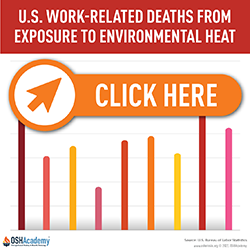Heat Stress and Safety
Introduction
Millions of U.S. workers are exposed to heat in their workplaces. Although illness from exposure to heat is preventable, every year, thousands become sick from occupational heat exposure, and some cases are fatal.
Most outdoor fatalities, 50% to 70%, occur in the first few days of working in warm or hot environments because the body needs to build a tolerance to the heat gradually over time. The process of building tolerance is called heat acclimatization. Lack of acclimatization represents a major risk factor for fatal outcomes.
Occupational risk factors for heat illness include heavy physical activity, warm or hot environmental conditions, lack of acclimatization, and wearing clothing that holds in body heat. Personal risk factors include medical conditions, lack of physical fitness, previous episodes of heat-related illness, alcohol consumption, drugs, and use of certain medication.
| Heat-Related Illness | Symptoms and Signs |
| Heat stroke |
|
| Heat exhaustion |
|
| Heat cramps |
|
| Heat syncope |
|
| Heat rash |
|
| Rhabdomyolysis (muscle breakdown) |
|
Management should commit to preventing heat-related illness for all employees regardless of their heat tolerance levels. Measurement of heart rate, body weight, or body temperature can provide individualized data to aid decisions about heat controls.
OSHA Regulations
Under the General Duty Clause, Section 5(a)(1) of the Occupational Safety and Health Act of 1970, employers are required to provide their employees with a place of employment that "is free from recognized hazards that are causing or likely to cause death or serious harm to employees." This includes heat-related hazards that are likely to cause death or serious bodily harm.
Knowledge Check Choose the best answer for the question.
1-1. When do most outdoor workplace heat-related fatalities occur?
You forgot to answer the question!

